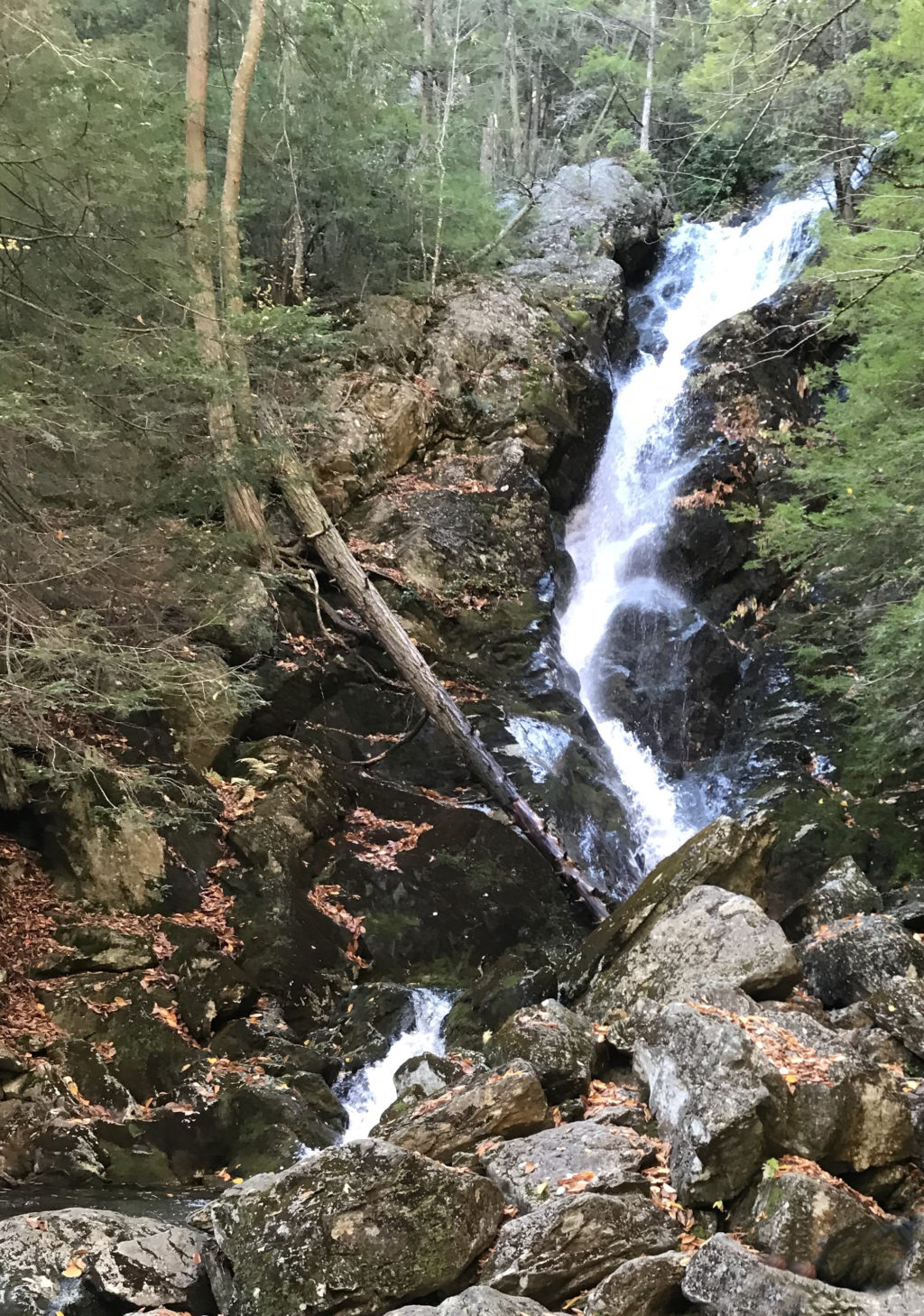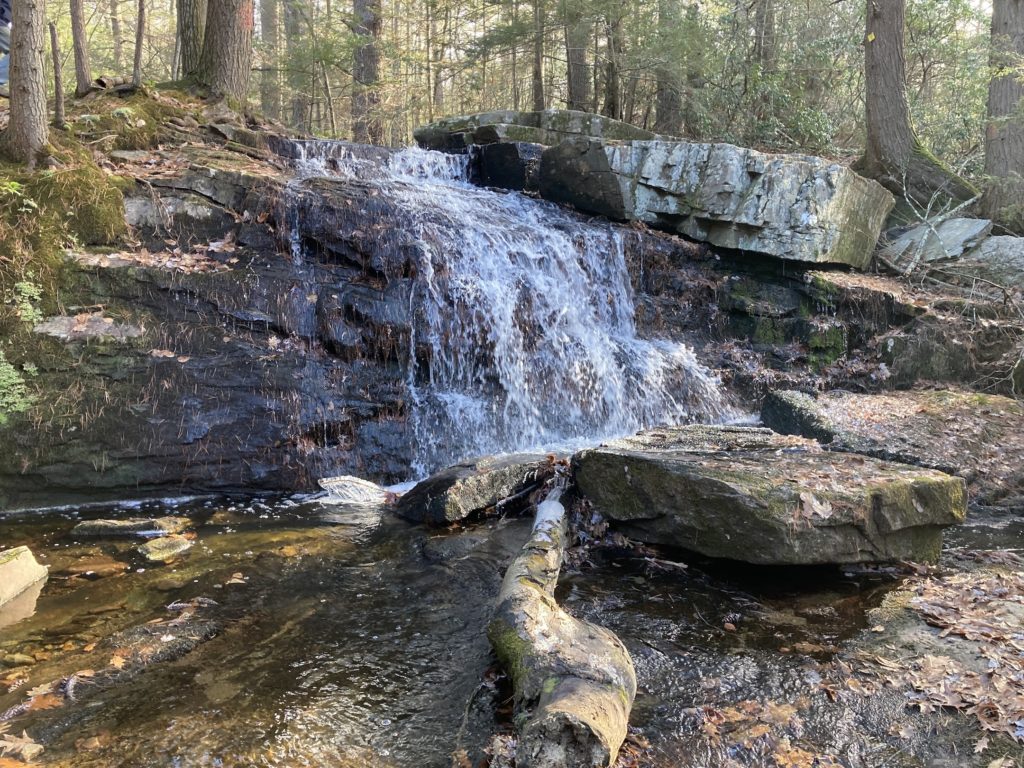Almanac: Falling Water

Upper Race Brook Falls in southwestern Massachusetts. Photo: David Ratner
In the past month I’ve had the pleasure of experiencing three new-to-me waterfalls; two in Massachusetts (on Dunlop Brook in Pelham, just off Amherst Rd, and along Race Brook near Sheffield) and one in the Adirondacks (Death Brook Falls near Raquette Lake). None of these is majestic in the Niagara sort of way, but each is lovely and captivating in its own sort of way.
It was at the top of Death Brook falls, sitting on a broad slab of rock eating some lunch and listening to the quiet gurgle in the pools just before the water plunged over the lip of the falls, that it occurred to me to wonder why the heck I and so many other people find waterfalls so alluring. On the face of it, there’s no reason that water falling over rocks should be any more interesting or compelling than water laying still in a pond or river. But people go to great lengths to view large waterfalls and find delight in even the most diminutive rivulet that happens to cascade over more than a couple of feet of rock.
Why?
This is precisely the kind of question that one ought to think twice about before attempting to answer. In a recent book, Michael Pollan quotes a Native American who was mildly exasperated at being asked so many questions: “That’s the trouble with you Whites—you always want to know everything. We just experience it.”
Point taken.
If ever there was a white person vulnerable to the lure of wanting to know everything, it’s me. I’m hopelessly curious. And, as readers of this column know, I delight in exploring what other people have discovered (often after decades of difficult observations) about whatever happens to spark my curiosity along a trail.
At the same time, there is deep wisdom in “just experiencing,” and another part of me is entirely uninterested in the answering of questions and the itch of curiosity. I smiled at myself—selves—sitting there at the top of the falls, listening to this inner dialog. I finished my granola bar, settled myself on the cool rock, and took a couple of deep breaths. I watched the ripples on the flowing water. I listened and heard no insects, birds, or human-made sounds. I smelled the clean air and felt how unusually warm it was on my skin that day. I set the “Why?” aside for a few minutes and just…sat.

That was lovely, and very pleasurable…but it was also pleasurable, once I returned home, to poke into the question that I had tucked into a mental pocket, like a pretty rock, back at the waterfall. Turns out I have a lot of company in my curiosity about the mysterious pull of waterfalls. I found a range of possible explanations for their allure, including: that we respond to them because we, ourselves, are mostly made of water and, thus feel a kinship with them; that falling water seems cleaner and safer than still water; that the white noise of a waterfall is restful; and that waterfalls generate calming negative ions.
This last idea is interesting and deserves a quick digression. It’s true that the physical force of water smashing against rocks generates species of atoms or molecules with an extra electron attached, giving them a negative charge. A group of curious researchers spent three years monitoring ion levels at five waterfalls in the Austrian Alps proving this beyond a shadow of a doubt. But whether negative ions have any effects on human health or moods is, at best, extremely uncertain. It’s very likely that whatever calming feelings one might have in the vicinity of a waterfall are due to the alchemy of sights, sounds, and smells rather than any effects that short-lived negative ions might have in our bodies.
Finding no consensus about why waterfalls exert the pull on humans that they do, I’ll offer my own ideas. To me, the attraction of a large-volume, Niagara-scale waterfall is very different from the pull of the small-volume falls such as those I’ve recently enjoyed. Large waterfalls, to me, are all about nature’s power: the thunder of water, the huge force of it if you put your hand or body in it, are impressive and awe-inspiring in the same way that a thunderstorm, or a blizzard, or a volcano are impressive and captivating. I suspect a key ingredient in the emotions we feel when witnessing any unleashed power in nature is fear. A large waterfall or a raging cascade are both potentially lethal, just like a bolt of lightning or powerful storm. But when we can witness such forces while still being safe (e.g., on a porch watching a thunderstorm roll in or behind a railing at the lip of a huge waterfall) we can experience that tingle of fear rooted in ancient neural patterns blended with the awe that comes from the sheer power involved in the display.
The pleasure of smaller falls and cascades, for me, has different emotional shadings. The sound of gently falling water has a musical and ever-changing quality to my ears. I suppose you could call it white noise, but it seems much richer in tones and variations than anything emitted by a machine. The motion of falling water, which seems both uniform and ever-changing, is hypnotic in something of the same way that the flames of a campfire entrance: the inanimate becomes animate, almost animal, dancing with gravity, sparkling with light, and speaking in an elemental language that has been a part of human experience for generations beyond counting.
Why do waterfalls—and sunsets, flowers, starry skies, and meteors (among many things) appeal to us? Why do we find some things so beautiful? It’s not wrong to ask such questions, but it is also deeply right, sometimes, to let the questions appear, and then evaporate, like morning dew, leaving behind a calm state of quiet wonder and appreciation for the gift of being alive and aware in this deeply mysterious world of ours.
Almanac is a regular Indy column of observations, musings, and occasional harangues related to the woods, waters, mountains, and skies of the Pioneer Valley. Please feel free to comment on posts and add your own experiences or observations.
